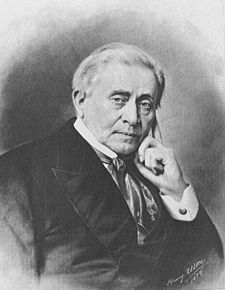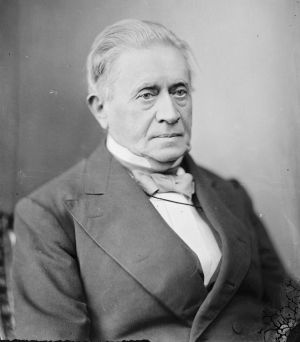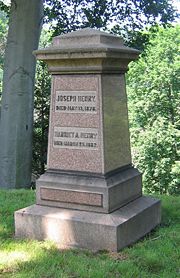Joseph Henry
|
Joseph Henry | |
|---|---|
 | |
| Born |
December 17 1797 |
| Died | May 13 1878 (aged 80) |
Joseph Henry (December 17 1797 – May 13 1878) was a Scottish-American scientist who served as the first Secretary of the Smithsonian Institution. During his lifetime, he was considered one of the greatest American scientists since Benjamin Franklin. While building electromagnets, Henry discovered the electromagnetic phenomenon of self-inductance. He also discovered mutual inductance independently of Faraday, though Faraday was the first to publish his results.[1][2] Henry's work on the electromagnetic relay was the basis of the electrical telegraph, jointly invented by Samuel Morse and Charles Wheatstone.
The SI unit of inductance, the henry, is named after Joseph Henry.
Early years
Joseph Henry was born on December 17th, 1799 in Albany, New York to two immigrants from Scotland, Ann Alexander Henry and William Henry. His parents were poor, and Joseph’s father died while he was still a young boy. Henry was sent to live with his grandmother in Galway, Saratoga County, New York when he was seven. His father died a few years later. From the age of ten he worked at a general store, and attended school in the afternoons. It was while living in Galway that he accidentally stumbled across the village library while chasing his pet rabbit, and from a perusal of its collection developed a keen interest in literature. When he was 14, he moved to Albany to live with his mother, and worked for a brief time as a silversmith, where he developed practical skills that later proved helpful in designing his experiments.
Joseph’s first love was theater and he came very close to becoming a professional actor. He joined a local theater group called the Rostrum, for which he wrote plays and created set designs. Once, while ill for a few days, he picked up a book left by a boarder in his home, Popular Lectures on Experimental Philosophy, Astronomy and Chemistry, by G. Gregory. This book so inspired him that he soon gave up stage management, and in 1819, entered The Albany Academy, where he was given free tuition, and supported himself with teaching and private tutoring positions. He intended to go into the field of medicine, but, in 1824, he was appointed an assistant engineer for the survey of the State road being constructed between the Hudson River and Lake Erie. From then on, he was inspired to a career in civil or mechanical engineering.
Joseph Henry excelled at his studies (so much so, that he would often be helping his teachers teach science) and, by 1826, he joined the academy staff as an assistant, and was appointed Professor of Mathematics and Natural Philosophy by Principal T. Romeyn Beck two years later.
Henry's curiosity about terrestrial magnetism lead him to experiment with magnetism in general. In 1827, he read his first paper, On some modifications of the electro-magnetic apparatus. He was the first to coil insulated wire tightly around an iron core in order to make an extremely powerful electromagnet, improving on William Sturgeon’s electromagnet, which used loosely coiled uninsulated wire. Using this technique, he built the most powerful electromagnet at the time for Yale. He also showed that, when making an electromagnet using just two electrodes attached to a battery, it is best to wind several coils of wire in parallel, but when using a set-up with multiple batteries, there should be only one single long coil. The latter made the telegraph feasible.
He took what he had learned a step further and, in 1831, created one of the first machines to use electromagnetism for motion. This was the earliest ancestor of modern DC motor. It did not make use of rotating motion, but was merely an electromagnet perched on a pole, rocking back and forth. The rocking motion was caused by one of the two leads on both ends of the magnet rocker touching one of the two battery cells, causing a polarity change, and rocking the opposite direction until the other two leads hit the other battery.
Here, Henry also discovered the property of self inductance. Around the same time, the British scientist Michael Faraday discovered it as well and, being first to publish his results, became the officially recognized discoverer of the phenomenon.
In 1848, Joseph Henry worked in conjunction with Professor Stephen Alexander to determine the relative temperatures for different parts of the solar disk. Using a thermopile, they determined that sunspots were cooler than the surrounding regions.[3][4][5][6] This work was shown to the astronomer Angelo Secchi who extended it, but with some question as to whether Henry was given proper credit for his own earlier work.[7]
Influences in aeronautics
Prof. Henry was introduced to Prof. Thaddeus Lowe, a balloonist from New Hampshire who had taken interest in the phenomena of lighter-than-air gases, and exploits into meteorology, in particular, the high winds which we call the Jet stream today. It was Lowe's intent to make a transatlantic crossing via an enormous gas-inflated aerostat. Henry took a great interest in Lowe's endeavors so much as to support and promote him among some of the more prominent scientists and institutions of the day.
In June of 1860, Lowe had made a successful test flight with his gigantic balloon, first named the City of New York hence renamed The Great Western, flying from Philadelphia to Medford, New York. Lowe would not be able to attempt a transatlantic flight until late Spring of the next year. Henry convinced Lowe to take his balloon to a point more West and fly the balloon back to the eastern seaboard, an exercise that would keep his investors interested.
Lowe took several smaller balloons to Cincinnati in March 1861. On April 19, conditions were perfect enough for him to take off on a fateful flight that landed him in Confederate South Carolina. With the Southern States seceding from the union, and the onset of civil war, Lowe abandoned further attempts at a transatlantic crossing and, with Henry's endorsement, went to Washington to offer his services with use of balloons. Joseph Henry submitted a letter to the Secretary of War, Simon Cameron showing his endorsement:
- Hon. SIMON CAMERON:
- DEAR SIR: In accordance with your request made to me orally on the morning of the 6th of June, I have examined the apparatus and witnessed the balloon experiments of Mr. Lowe, and have come to the following conclusions:
- 1st. The balloon prepared by Mr. Lowe, inflated with ordinary street gas, will retain its charge for several days.
- 2d. In an inflated condition it can be towed by a few men along an ordinary road, or over fields, in ordinarily calm weather, from the places where it is galled to another, twenty or more miles distant.
- 3d. It can be let up into the air by means of a rope in a calm day to a height sufficient to observe the country for twenty miles around and more, according to the degree of clearness of the atmosphere. The ascent may also be made at night and the camp lights of the enemy observed.
- 4th. From experiments made here for the first time it is conclusively proved that telegrams can be sent with ease and certainty between the balloon and the quarters of the commanding officer.
- 5th. I feel assured, although I have not witnessed the experiment, that when the surface wind is from the east, as it was for several days last week, an observer in the balloon can be made to float nearly to the enemy's camp (as it is now situated to the west of us), or even to float over it, and then return eastward by rising to a higher elevation. This assumption is based on the fact that the upper strata of wind in this latitude is always flowing eastward. Mr. Lowe informs me, and I do not doubt his statement, that he will on any day which is favorable make an excursion of the kind above mentioned.
- 6th. From all the facts I have observed and the information I have gathered I am sure that important information may be obtained in regard to the topography of the country and to the position and movements of an enemy by means of the balloon now, and that Mr. Lowe is well qualified to render service in this way by the balloon now in his possession.
- 7th. The balloon which Mr. Lowe now has in Washington can only be inflated in a city where street gas is to be obtained. If an exploration is required at a point too distant for the transportation of the inflated balloon, an additional apparatus for the generation of hydrogen gas will be required. The necessity of generating the gas renders the use of the balloon more expensive, but this, where important results are required, is of comparatively small importance.
- For these preliminary experiments, as you may recollect, a sum not to exceed $200 or $250 was to be appropriated, and in accordance with this Mr. Lowe has presented me with the inclosed statement of items, which I think are reasonable, since nothing is charged for labor and time of the aeronaut.
- I have the honor to remain, very respectfully, your obedient servant,
- JOSEPH HENRY,
- Secretary Smithsonian Institution.
- I have the honor to remain, very respectfully, your obedient servant,
On Henry's recommendation Lowe went on to form the Union Army Balloon Corps and served two years with the Army of the Potomac as a Civil War Aeronaut.
Influences in room acoustics
Over 150 years ago, Joseph Henry identified the room acoustics phenomena we now call direct sound, early reflections, and reverberation. He demonstrated the early sound integration period and laid the ground work for further fundamental research on early reflections that was not followed up until the work at Gottingen University in the 1950-1960’s. He brought a robust scientific approach to the subject of acoustics – a subject which is plagued by misunderstanding and misinformation to this day.
Joseph Henry devised a beautifully simple experiment to demonstrate the integration of direct and early sound. A listener, standing in an open space 100 feet from a wall, claps his hands and hears an echo. He gradually approaches the wall, clapping, until no echo is perceived, at a distance of 30 feet – the “Henry Distance” – equating to an early sound integration time of 60 ms.[8]
Later years
As a famous scientist and director of the Smithsonian Institution, Henry received visits from other scientists and inventors who sought his advice. Henry was patient, kindly, self-controlled, and gently humorous.[9] One such visitor was Alexander Graham Bell who on March 1, 1875 carried a letter of introduction to Henry. Henry showed an interest in seeing Bell's experimental apparatus and Bell returned the following day. After the demonstration, Bell mentioned his untested theory on how to transmit human speech electrically by means of a "harp apparatus" which would have several steel reeds tuned to different frequencies to cover the voice spectrum. Henry said Bell had "the germ of a great invention." Henry advised Bell not to publish his ideas until he had perfected the invention. When Bell objected that he lacked the necessary knowledge, Henry firmly advised: "Get it!"
On June 25 1876, Bell's experimental telephone (using a different design) was demonstrated at the Centennial Exhibition in Philadelphia where Joseph Henry was one of the judges for electrical exhibits. On January 13, 1877 Bell demonstrated his instruments to Henry at the Smithsonian Institution and Henry invited Bell to show them again that night at the Washington Philosophical Society. Henry praised "the value and astonishing character of Mr. Bell's discovery and invention."[10]
Henry died on May 13, 1878 and was buried a few days later in Oak Hill Cemetery in northwest Washington, D.C.
Career

- 1826 - Professor of Mathematics and Natural Philosophy at The Albany Academy, New York.
- 1832 - Professor at Princeton.
- 1835 - invents the electromechanical relay.
- 1846 - First secretary of the Smithsonian Institution until 1878, who contended with the notorious antics of the Megatherium Club.
- 1848 - Edited Ephraim G. Squier and Edwin H. Davis' Ancient Monuments of the Mississippi Valley, the Institution's first publication.
- 1863 - Cofounder and second president of National Academy of Sciences. The Joseph Henry Press, a publication arm of the NAS, is named for him.
See also
Notes
- ↑ Ulaby, Fawwaz (2001-01-31). Fundamentals of Applied Electromagnetics, 2nd edition, Prentice Hall, p. 232. ISBN 0-13-032931-2.
- ↑ Joseph Henry. Distinguished Members Gallery, National Academy of Sciences. Retrieved 2006-11-30.
- ↑ Henry, Joseph (1845). On the Relative Radiation of Heat by the Solar Spots. Proceedings of the American Philosophical Society 4: 173–176.
- ↑ Magie, W. F. (1931). Joseph Henry. Reviews of Modern Physics 3: 465–495.
- ↑ Benjamin, Marcus (1899). The Early Presidents of the American Association. II.. Science 10: 675.
- ↑ Hellemans, Alexander and Bryan Bunch (1988). The Timetables of Science. New York, New York: Simon and Schuster, 317. ISBN 0671621300.
- ↑ Mayer, Alfred M.. (1880). "Henry as a Discoverer". A Memorial of Joseph Henry: 475–508. Washington: Government Printing Office. Retrieved on 2007-09-23.
- ↑ An auralization of Henry's experiment
- ↑ Alexander Graham Bell and the Conquest of Solitude, Robert V. Bruce, pages 139-140
- ↑ Alexander Graham Bell and the Conquest of Solitude, Robert V. Bruce, page 214
ReferencesISBN links support NWE through referral fees
- Ames, Joseph Sweetman, ed. The discovery of induced electric currents, Vol. 1. Memoirs, by Joseph Henry. New York, Cincinnati [etc.] American book company [c1900] LCCN 00005889
- Coulson, Thomas, Joseph Henry: His Life and Work, Princeton, Princeton University Press, 1950.
- Henry, Joseph, Scientific Writings of Joseph Henry. Volumes 1 and 2, Smithsoninan Institution, 1886.
- Moyer, Albert E., Joseph Henry: The Rise of an American Scientist, Washington, Smithsonian Institution Press, 1997. ISBN 1-56098-776-6
External links
- Published physics papers - On the Production of Currents and Sparks of Electricity from Magnetism and On Electro-Dynamic Induction (extract)
- The Joseph Henry Papers Project
- Biographical details] - Proceedings of the National Academy of Sciences (1967), 58(1), pages 1 - 10.
- Dedication ceremony for the Henry statue (1883)
Credits
New World Encyclopedia writers and editors rewrote and completed the Wikipedia article in accordance with New World Encyclopedia standards. This article abides by terms of the Creative Commons CC-by-sa 3.0 License (CC-by-sa), which may be used and disseminated with proper attribution. Credit is due under the terms of this license that can reference both the New World Encyclopedia contributors and the selfless volunteer contributors of the Wikimedia Foundation. To cite this article click here for a list of acceptable citing formats.The history of earlier contributions by wikipedians is accessible to researchers here:
The history of this article since it was imported to New World Encyclopedia:
Note: Some restrictions may apply to use of individual images which are separately licensed.

